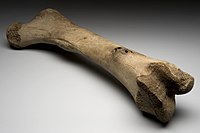
Photo from wikipedia
Objective: To assess the viability and biomechanics of bare diced cartilage grafts. Methods: Cartilage samples were collected from 1 ear in 15 rabbits as well as costal cartilage. Each rabbit… Click to show full abstract
Objective: To assess the viability and biomechanics of bare diced cartilage grafts. Methods: Cartilage samples were collected from 1 ear in 15 rabbits as well as costal cartilage. Each rabbit was inserted bare diced- and single-strip costal-cartilage grafts, respectively, into paraspinal subcutaneous pockets: after euthanasia at 2 months, specimens were weighed, with diced cartilage grafts examined histomorphologically by hematoxylin-eosin staining, masson trichrome staining, and immunohistochemistry. Finally, biomechanical properties of grafts were assessed. Results: Bare diced cartilage grafts were connected into an integrated mass after 2 months, and inward growth of fibrous tissues and angiogenesis were observed. Mean wet weights of diced cartilage grafts were 1.603 ± 0.278 and 1.662 ± 0.204 g pre- and postoperation, respectively; those of costal cartilage grafts were 0.053 ± 0.008 and 0.058 ± 0.008 g, respectively. In compression assays, mean modulus values of elasticity at yield in diced- and costal-cartilage grafts were 7.65 ± 0.59 and 22.30 ± 1.15 MPa, respectively (P < 0.05); mean stress values were 4.07 ± 0.38 and 12.50 ± 1.15 MPa, respectively (P < 0.05). In the tensile test, mean modulus values of elasticity at yield of diced- and costal-cartilage grafts were 4.70 ± 0.78 and 10.59 ± 1.39 MPa, respectively (P < 0.05), mean stress values were 0.82 ± 0.05 and 1.76 ± 0.21 MPa, respectively (P < 0.05). Conclusions: Diced cartilage grafts had favorable viability and growth. Despite reduced elasticity and stress values, they still can be served as substitute for supportive filling materials.
Journal Title: Journal of Craniofacial Surgery
Year Published: 2017
Link to full text (if available)
Share on Social Media: Sign Up to like & get
recommendations!